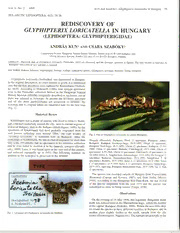
Rediscovery of Glyphipterix loricatella in Hungary (Lepidoptera: Glyphipterigidae) PDF
Preview Rediscovery of Glyphipterix loricatella in Hungary (Lepidoptera: Glyphipterigidae)
Vol. 6 No. 2 1999 KUN and SZABOKY: Glyphipterix loricatella in Hungary 75 HOLARCTIC LEPIDOPTERA, 6(2): 75-76 REDISCOVERY OF GLYPHIPTERIX LORICATELLA IN HUNGARY (LEPIDOPTERA: GLYPHIPTERIGIDAE) ANDRAS KUN AND CSABA SZABOKY 1 2 1 Lepidoptera Section, Hungarian Natural History Museum, Baross utca 13, H-1088 Budapest, and 2 Forest Research Institute, Frankel Leo utca 42-44, H-1023 Budapest, Hungary ABSTRACT.- Historical data of Glyphipterix loricatella (Treitschke, 1833) are discussed, and the lectotype specimen is figured. The type locality is restricted as "Budapest." Discovery of new colonies is reported. KEY WORDS: Balkans, behavior, biogeography, biology, ecology, endangered species, Glyphipterix, lectotype, Romania, Serbia, taxonomy. Glyphipterix loricatella (Treitschke) was discovered in Hungary. In the original description, no exact locality is given; it is mentioned only that the first specimens were captured by Kindermann (Treitsch- ke, 1833). According to Diakonoff (1986), four syntype specimens exist in the Treitschke collection housed in the Hungarian Natural History Museum (HNHM) (originally described in Aechmia); one of them was selected as lectotype. At present the lectotype specimen and all the three paralectotypes are preserved in HNHM: the lectotype and its original labels are illustrated here for the first time (Fig. 1). Historical Review Kindermann was a dealer of insects, who lived in Ofen (= Buda), and collected extensively around the city, later in various regions of historical Hungary, then in the Balkans (Abafi-Aigner, 1898). As the specimens of Kindermann had most probably originated from the well known collecting sites around 'Ofen,' the type locality of Fig. 2. Pair of Glyphipterix loricatella in copula (Budapest). "Aechmia loricatella" is restricted here as Budapest. After the collectings of Kindermann, the species had disappeared for more than Hungary (Pannonia): Budapest, Pavel (1 specimen); Budapest, Anker; fifty years. Frivaldszky had no specimens in his extensive collection Budapest; Budapest Szechenyi-hegy, 30-V-1897, Uhryk (1 specimen); and he even failed to mention it in his faunistic synopsis (Frivald- Budapest, Svab-hegy, 28-V-1899, Uhryk (1 specimen); Budapest, 17-VI- szky, 1865). Later, it was found again at the very end of the century, 1940, Uhryk (1 specimen); Budaors, Csiki-hegyek, 29-V-1944, Uhryk (3 and collected repeatedly up to 1971. The following material (in specimens); 4-VI-1944, Uhryk (3 specimens); Fabricius E. (4 specimens); 4- VI-1944, Szocs J.; Nagykovacsi, Juliannamajor, 3-VI-1951, Dr. Lengyel (1 addition to the syntypes) is preserved in the HNHM: specimen); Budapest, Harmashatar-hegy, 29-V-1955, Neugebauer T. (6 specimens); Budaors, 20-V-1960, Szocs J. (1 specimen); 22-V-1960, Szocs J. (7 specimens); 25-V-1965 Szb'cs J. (1 specimen); Budapest, Orban-hegy, 24-V-1971, light-trap. Budapest, Harmashatar-hegy, 18-V-1996, leg. A. Run (2 specimens). The species was recorded outside of Hungary from Transylvania (Romania) (Capu§e and Kovacs, 1987), and from Serbia (Meess, 1910). According to the Hungarian Red Data Book, the last record of the species originated from the year 1971 and the species was considered as close to being extinct (Varga, 1990). Observations On the evening of 16 May 1996, this legendary Hungarian sedge Designated moth was rediscovered in the Harmashatar-hegy, within the borders A.Diakonoff, 1 of the capital, Budapest (Szaboky, 1996). Within the next three days we found the species in three different localities in Budapest, and in another place slightly further to the north, outside from the city Fig. 1. Lectotype of Glyphipterix loricatella (in HNHM). border (Pilisborosjeno: Nagykevely). The habitats are generally in the 76 KUN and SZABOKY: Glyphipterix loricatella in Hungary HOLARCTIC LEPIDOPTERA clearings of oak-shrub forest-steppe on calcareous ground. The specimens were observed in the early morning and at twilight. It was not possible to collect adults in bright sunshine. They were flying about 20-30cm over the ground for 2-3m distances. They took rests on various grasses. Copulation was observed only on one occasion (0746h, 18 May 1996): the pair was sitting on a grass for ca. 30 minutes (Fig. 2). Oviposition has not been observed. Our special effort resulted in the rediscovery of the Hungarian sedge moth in its historical sites, as well as the new localities detected. On the other hand, no data concerning its life history have been obtained yet. In the near future, special attention will be paid to ecological studies to clarify its conservation status and to outline recommendations of habitat management for this species. The Hungarian sedge moth presumably has a wider distribution than shown by present records, and some larger colonies may be flourishing in various, already protected areas. According to the basic knowledge of the imaginal behavior, there is good hope of finding more colonies of them. LITERATURE CITED Abafi-Aigner, L. 1898. [The History of Lepidopterology in Hungary]. Budapest: Kir. Magyar Termeszettudomanyi Tarsulat. 194pp. (in Hungarian) Capu§e I., and A. Kovacs 1987. Catalogue de la Collection de Lepidopteres ,,Ldszlo Dioszeghy" du Musee Departamental Covasna, Sfintu Gheorghe. Institut de Speologie "Emile Racovitza". Bucharest. 397pp. Diakonoff A. 1986. Glyphipterigidae auctorum sensu lato (Glyphipterygidae sensu Meyrick, 1913). In Microlepidoptera Palaearctica. 1. Karlsruhe: G. Braun Verlag. 2 v. (443pp.+ 12 pi). Frivaldszky I. 1865. [Characteristic Data of the Fauna of Hungary]. Magyar Tudomdnyos Akademia Evkonyvei (Budapest), ll(4):l-274, 13 pis. (in Hungarian) Meess, A., and Spuler A. 1910. Gelechiidae bis Nepticulidae, Eriocraniidae und Micropterygidae. In A. Spuler (ed.), Die Schmetterlinge Europas. II. Band, 330-484, Stuttgart: E. Schweizerbart'sche Verlag. Szaboky, C. 1996. (The recurrance of Glyphipterix loricatella Treitschke, 1933 in Hungary). Folia Ent. Hung. (Budapest), 57:311-312. (in Hungarian) Treitschke, F. 1833. Die Schmetterlinge von Europa. Neunter Band. Zweite Abteilung. Leipzig: E. Fleischer. 294 pp. Varga, Z. 1990. [The order Lepidoptera]. In Z. Rakonczay (ed.), [Hungarian Red Data Book], 188-244. Budapest: Akad. Kiado. (in Hungarian)
